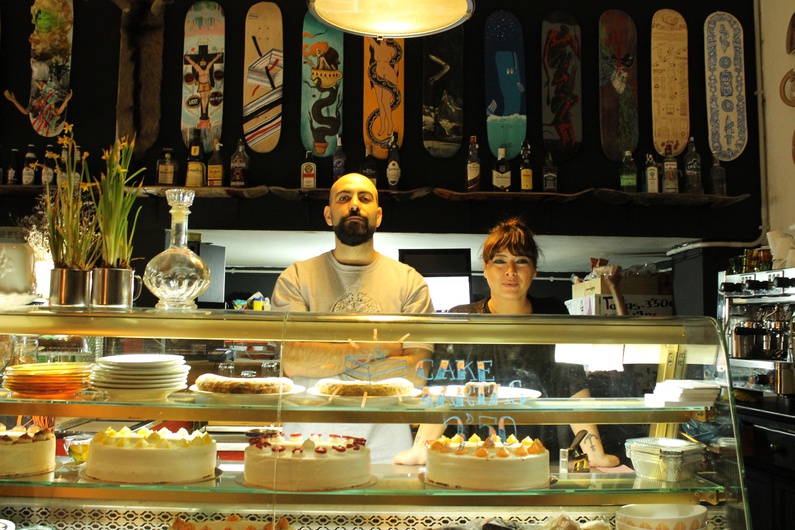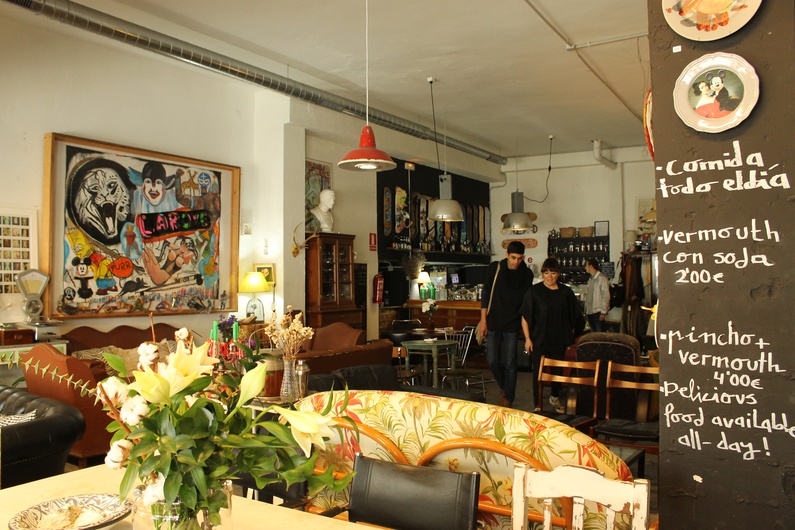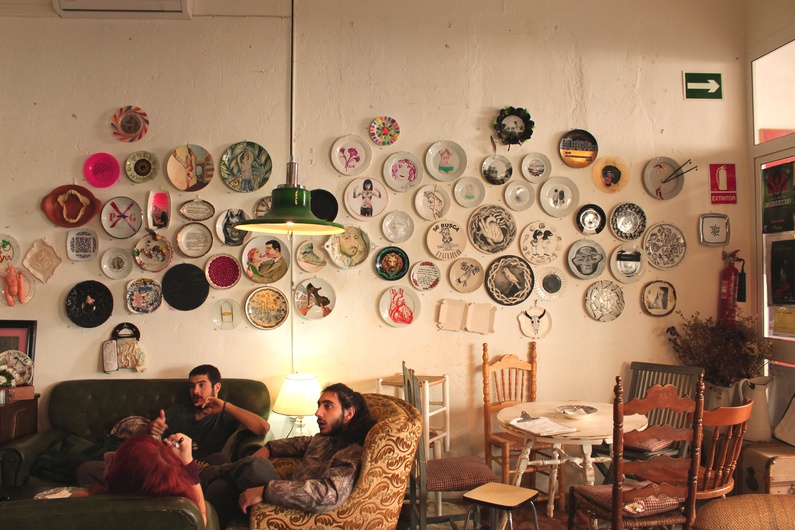
After the Crisis: Seville's Artistic Response
Published on
Translation by:
Alice RobertsonSetting off for Seville, the city where a staggering 50.6% of 25-44 year olds are unemployed, I was steeling myself to encounter Spain’s underdogs. I pictured down-and-outers denied jobs and drained of joie de vivre, floored by the financial crisis. But happily Seville surprised me when I came across Red House, where postmodern artists are turning to the Pre-Raphaelites for inspiration.
“The financial crisis? Why dwell on something that depressing?”
Such is Alvaro Diaz’s reply when I ask about the situation for young people in Seville, accompanied by a cheery wave at a group of said young people as they stroll into Red House. Alvaro, 30, hails from Huelva, and Red House is the café-gallery he launched in 2012, together with his wife Cristina Galeote. Both studied at the prestigious Royal Academy of Fine Arts in Seville. And quite apart from their impressive credentials, Alvaro and Cristina clearly possess that rarest and most useful of accomplishments: they’re instantly interesting.
 “What gave you the inspiration for this place? What’s the ethos behind it?” I ask. We’ve not got long to chat. At Red House there’s always plenty to be done, morning until night.
“What gave you the inspiration for this place? What’s the ethos behind it?” I ask. We’ve not got long to chat. At Red House there’s always plenty to be done, morning until night.
“The idea came to us when we were travelling. We went to Madrid, London, Berlin, Moscow,” Alvaro tells me. “And in every city, we came across similar creative spaces. So we thought we’d try our luck in Seville. There was nothing like it here at the time.” Red House – right up to its name, Alvaro explains – was conceived as an homage to William Morris, the 19th century English Pre-Raphaelite artist. Hence my fascination. I’d imagined Spain in a fog of economic decline, its disillusioned graduates reeling from the crisis and stuck on the dole, dogged by melancholy.
“Of course,” Alvaro continues, “We’re all worried about the crisis. But our approach is to stay positive and hope that our attitude can rub off on other people. We want to encourage a spirit of entrepreneurship and creativity in Spain. It’s important to have places where people can come together and support each other through difficult times.” He is waving again – more regulars have arrived.
MORRIS'S MODERN-DAY DEVOTEES
Optimism abounds at Red House. There is a tangible community spirit here – coupled, of course, with a tinge of Morris. The café looks a bit like a giant guest bedroom, complete with snug sofas and large tables. Contrasting constituent ingredients render the room eclectic, to put it mildly, and yet the overall effect remains somehow harmonious. The café, doubling as a gallery, sells an assortment of artwork. Besides paintings, there are decorated plates by artists from all over Spain, skateboards turned into sculptures, or vintage furnishings. And one of the walls enshrines a series of Dash Snow-esque polaroids, proudly portraying a motley mix of male and female genitalia.
Yet Morris’s own Red House was designed to meet its inhabitants’ daily needs, practical as much as artistic. Alvaro and Cristina are guided by the same principle: “Our Red House is a place where people can come and feel at home, as well as discovering new artists. We often organise exhibitions and concerts to showcase local talent.” And just as William Morris and his fellow Pre-Raphaelites lamented the Industrial Revolution’s impact upon artisanship and time-honoured crafts, Seville's Red House is waging its own war against mass production. Everything sold or used in the café is locally produced – everything, that is, save the Californian beer that Alvaro has just served me: “We love traditional Andalusian food. But it’s nice if we can introduce our customers to something a little different.”
RED HOUSE, RED HOME
Appearances can be deceiving. Red House may be all bustle now. But for its founders, getting here hasn’t been the smoothest of rides. “It’s easier to open a pharmacy in Kabul than a café in Seville,” Alvaro says. It's the first in a litany of complaints against the Spanish government. “In a country where the unemployment rate is so astronomically high, they should be encouraging people to start businesses. They’re basically doing the opposite.”
“And you don’t want to do what everyone else is doing, and get out of here?” I ask.
“We both love to travel,” he replies, “But Seville is where we’ve made our home. It’s where we have our family, our friends. Besides, we could never have a place like this for the same price in London.” He tells me that Spain’s young artists, despite having to fight to continue pursuing their craft, are nonetheless doing better than young doctors or young architects. “As artists, we’re able to work on the fringes of society. Cristina sells and exhibits her paintings, I make films – I shoot a lot of music videos." He adds that here in Seville, there’s a genuine fellowship amongst young entrepreneurs – a spirit of cooperation and mutual support. “A colleague of mine recently opened a tattoo parlour,” Alvaro explains. “And we were happy to use our contacts and our standing on social media to help him get on the radar. My father is an architect. He was out of work for a while, so he devoted some of his time to this place. So now Red House is functional as well as beautiful.”
"IT WON'T LAST FOREVER"
“Have you noticed your customers changing over time? How has Seville changed?” I can’t help but suspect that the downturn has seen Spaniards spend less time and less money in cafés and galleries. Yet: “Although people didn’t really get us at first, they do now,” Alvaro insists. “When we launched Red House, people thought we were just a furniture store or a normal gallery. But not any more. Now, young artists who’d left Seville to look for work are coming back and rebuilding their careers here. Many are launching businesses of their own.”
Red House is filling up. Cristina and her colleagues are growing visibly flustered. I don’t want to keep Alvaro any longer, so I return to my original question.
“The effects of the financial crisis are still felt,” comes the reply this time. “That won’t stop anytime soon. But nor will it last forever. We can’t ignore it, but agonising about it isn’t helpful. We’re launching a new place soon, the No Lugar. We stay positive – no matter what.”
It seems Red House has every reason to look on the bright side. I’m not sure if a pharmacy in Kabul is easy to open or not. But a café in Seville can certainly change the face of society, and put art and artists alike back on the menu.
Discover the RED HOUSE PHOTO GALLERY HERE
© Photos: Valentina Cala & Katarzyna Piasecka
THIS ARTICLE FEATURES IN OUR SPECIAL SERIES DEVOTED TO seville as PART OF "EUTOPIA: TIME TO VOTE", A PROJECT RUN BY CAFÉBABEL IN PARTNERSHIP WITH THE HIPPOCRÈNE FOUNDATION, THE EUROPEAN COMMISSION, THE MINISTRY OF FOREIGN AFFAIRS AND THE EVENS FOUNDATION.
Translated from Sewilskie dzieci Williama Morrisa





